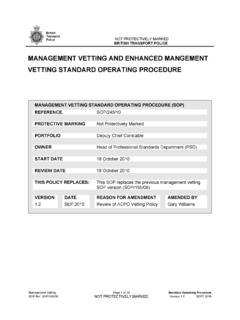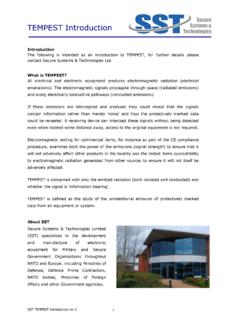Transcription of PSD: VETTING Policy & Procedures - British …
1 NOT protectively marked VETTING Policy March 2014, version 1 Page 1 of 13 NOT protectively marked PSD: VETTING Policy & Procedures Reference No. DCC/001/14 Policy Sponsor Deputy Chief Constable Policy Owner Head of the Professional Standards Department Policy Author Redacted Business Change Unit Effective Date 21st March 2014 Review Date 21st March 2016 Revision History Version Date Comments / Reason for Amendments Amended By 08/11/2014 Re-design under Policy Project Redacted Business Change Manager 1 21/03/2014 Version 1 under new PSD Policy format Redacted Business Change Manager 21/03/2014 Issued for publication T/Chief Supt Redacted NOT protectively marked VETTING Policy March 2014.
2 Version 1 Page 2 of 13 NOT protectively marked CONTENTS Policy .. 3 Policy 3 SCOPE .. 3 PRINCIPLES .. 3 KEY INFORMATION .. 4 WHO TO CONTACT ABOUT THIS 4 MONITORING AND REVIEW .. 6 Procedures .. 7 NOT protectively marked VETTING Policy March 2014, version 1 Page 3 of 13 NOT protectively marked Policy Policy PURPOSE The publication of this Policy demonstrates the British Transport Police (BTP) commitment to minimising corruption and the potential for corruption within the force. It will provide the framework for structured and accountable Procedures for the VETTING of all BTP employees and other individuals as required, to ensure that those employed or engaged to work for or with BTP are appropriate to do so.
3 This Policy supports the safeguarding of criminal intelligence, operational, and financial assets, and seeks to preserve the safety, welfare and security of employees and the public. This Policy is directed towards enabling BTP to: Identify those individuals who should be vetted Identify the circumstances under which they should be vetted Set out the VETTING Procedures including VETTING renewal and aftercare Procedures SCOPE This Policy and procedure applies to: a. All BTP employees. Within this Policy and procedure, except where categories are specifically excluded, the term Employee includes police officers, special constables, all categories of non-warranted employees including police staff and PCSOs, agency and temporary contract workers, consultants, workers seconded to BTP from other organisations, auditors, community volunteers and those acting as our servants or agents b.
4 England, Wales and Scotland. PRINCIPLES This Policy is underpinned by the ACPO National VETTING Policy for the Police Community. Compliance with this Policy will be the responsibility all employees and affected individuals as set out at , and those within who recruit or manage staff, or who have responsibility to ensure National Security VETTING guidelines are adhered to. Self declaration is an essential part of compliance with this Policy , and affected individuals must ensure that relevant information that could affect their VETTING clearance is provided to the VETTING Unit. Failure to comply with the VETTING Policy and associated Procedures may result in misconduct or capability proceedings and could put employment or association with BTP at risk.
5 NOT protectively marked VETTING Policy March 2014, version 1 Page 4 of 13 NOT protectively marked KEY INFORMATION Further information on the ACPO National VETTING Policy for the Police Community can be found here. VETTING types There are two categories of VETTING : o Force VETTING o National Security VETTING There are various VETTING levels within these two categories, refer to the table on page 5. Force VETTING and National Security VETTING are separate processes, designed to counter specific threats. Force VETTING is to specifically provide a level of assurance, which National Security VETTING cannot provide, as to the integrity of individuals who have access to sensitive criminal intelligence, financial or operational police assets and premises.
6 National Security VETTING is relevant to Government information and cannot on its own, guarantee that an applicant will meet the BTP VETTING criteria. Its purpose is to protect sensitive government security information by providing an acceptable level of assurance as to the integrity of individuals who have access to protectively marked government assets and/or who require access to persons, sites and materials, at risk of terrorist attack. Terms & Definitions Personal Information Questionnaire (PIQ) this is the form that is used to record details of the applicant in relation to Recruitment VETTING and Non Police Personnel VETTING .
7 Non Police Personnel these are persons working with BTP who are not recruited as Police employees, for example maintenance contractors, Independent Advisory Groups and volunteers. This list is not exhaustive and the level of VETTING required should be checked in line with the access requirements set out in the table on page 4, advice should be sought from the VETTING Unit if in doubt. VETTING Verification Record is a form completed by the recruiting department and submitted with the PIQ to ensure that the necessary identity documents have been checked.
8 Where there is any doubt in relation to identity documents this should be referred to the Force VETTING & Auditing Manager (FVAM). Taint This term refers to matters which would impact on an employee s credibility to provide evidence or witness testimony on court. Dependent on an employee s role or prospective role with BTP, this will be a key consideration for VETTING clearance. Further information can be found in the Redacted WHO TO CONTACT ABOUT THIS Policy /PROCEDURE Any questions regarding this Policy or the associated Procedures should be directed to the BTP VETTING Unit at Redacted Table 1: VETTING Types and Renewal Periods* NOT protectively marked VETTING Policy March 2014, version 1 Page 5 of 13 NOT protectively marked VETTING TYPE PURPOSE RENEWALR ecruitment VETTING (RV) This allows police officers, police staff, Special Constables and PCSOs regular access to CONFIDENTIAL and occasional access to SECRET government or police assets.
9 It is designed to provide a level of assurance as to the trustworthiness and integrity of individuals whose work gives them unsupervised access to police premises. 10 years Management VETTING Allows regular access to SECRET government or police assets and occasional access to TOP SECRET police assets must be vetted to MV. MV is also a requirement for roles with duties, responsibilities or access that could present an increased risk to BTP and/ or the police service as designated by the FVAM. MV is also a pre-requisite for a Security Clearance (SC). 7 years, with annual reviews. NPPV1 Applies to those persons having unsupervised access to police premises but no access to any electronic systems and/or hard copy material.
10 In the main this applies to utility workers such as plumbers, electricians etc. 1 year NPPV2 Applies to those persons having frequent and regular unsupervised access to police premises and/or access to police information and/or hard copy material or protectively marked material, either on police premises or by remote access for example Independent Advisory Groups, volunteers, work experience students, and BTPA staff. Level 2 allows regular access to police protectively marked assets up to CONFIDENTIAL and occasional access up to SECRET. 3 years FORCE VETTING NPPV3 Applies to all Non Police Personnel who require long term, frequent and uncontrolled access to SECRET POLICE, and occasional access to TOP SECRET POLICE assets, for example IT contractors.











